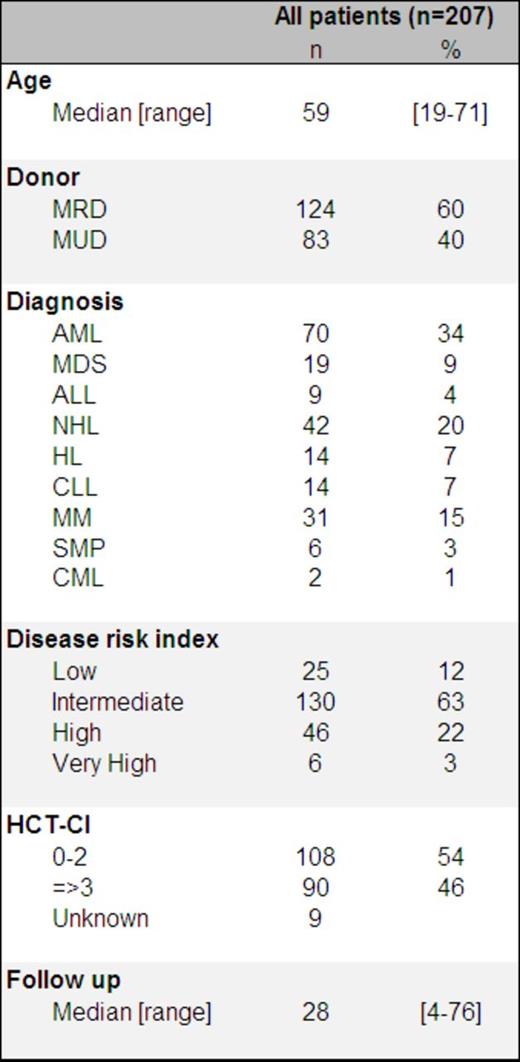Abstract
Allogeneic hematopoietic stem cell transplantation (Allo-HSCT) is a curative option for most of advanced hematological malignancies. In the last fifteen years, the development of reduced intensity conditioning (RIC) regimens allowed the use of Allo-HSCT in patients unfit for standard myeloablative regimens, with low procedure-related mortality and long term anti-tumor effect. Thus, RIC regimens were modified over years to improve survival as well as to decrease long term toxicity after Allo-HSCT but the optimal balance between safety and efficacy is still undefined. We report here our recent experience of RIC regimen based on fludarabine, intravenous busulfan and rabbit antithymocyte globulin (r-ATG).
Selection criteria were 1) patients undergoing first Allo-HSCT for hematological malignancies in our center from 2005 to 2012; 2) RIC regimen based on fludarabine (30 mg/m² daily, from day-6 to day-2), intravenous busulfan (3.2 mg/kg daily, at day-4 and day-3) and r-ATG (2.5 mg/kg daily, at day-2 and day-1 or at day-3 and day-2); 3) peripheral blood stem cell as graft source; 4) matched sibling donor (MSD) or 10/10 matched unrelated donor (MUD) as donor; 5) cyclosporine A as GVHD prophylaxis (started at day-1 at 3 mg/kg). Disease risk index (DRI) and HCT-CI score were applied to each patient to stratify the risk of relapse and non-relapse mortality (NRM) respectively.
Patient characteristics are illustrated in the Table 1. Two hundred and seven patients with a median age of 59 years (range (19-71) were analyzed. Only 25 patients (12%) had low risk disease according to the disease risk index (DRI, Armand et al., Blood, 2012) and 90 patients (46%) had HCT-CI => 3. Grade II-IV and grade III-IV acute graft-versus-host disease (GVHD) at day 100 were 23% and 9% percent respectively. Overall cumulative incidences of total and extensive chronic GVHD were 37% and 22% respectively. Early NRM (day-100) and overall NRM (5-year) were 5% and 22% respectively. The 5-year cumulative incidence of relapse was 36%. Five-year progression-free survival (PFS) and overall survival (OS) were 41% and 52% respectively. At last follow up, 101 patients were disease free. Among them, 85 (84%) were free of GVHD treatment suggesting an unaltered quality of life for long term cured patients.
Outcome according to age (< 60 and => 60) did not express different patterns. The use of MUD results in higher grade II-IV acute GVHD than with MRD transplant (MRD: 13% vs. MUD: 39%, p<0.001). This lead to higher NRM (MRD: 17% vs. MUD: 30%, p=0.013). Inversely, MUD recipients had lower 5-year incidence of relapse (MRD: 42% vs. MUD: 28%, p=0.044) than MRD recipients. This results in similar 5-year PFS (MRD: 41% vs. MUD: 41%, p=0.791) and 5-year OS (OS: MRD: 55% vs. MUD: 48%, p=0.128). Two-year OS was 84%, 68%, 48% and 17% in patients with low, intermediate, high and very high risk disease according to the DRI (p=0.005). Patients with HCT-CI => 3 had shorter OS than those with HCT-CI < 3 (5-year OS: 60% vs. 43%, p=0.013). In multivariate analyses, disease risk (intermediate, HR=2.0 (95CI: 0.8-5.1), p=0.140; high, HR=3.4 (95CI: 1.3-9.0), p=0.015; very high, HR=5.8 (95CI: 1.7-20.4), p=0.006), HCT-CI (=> 3, HR=1.9 (95CI:1.2-2.9), p=0.009) but not age or donor type significantly influenced OS.
RIC Allo-HSCT prepared by fludarabine, 2 days of intravenous busulfan and 2 days of r-ATG results in low incidence of NRM and prolonged survivals. Few patients were concerned with recurrent extensive chronic GVHD, and most of survivors were actually free of both disease and immunosuppressive treatment, suggesting a preserved quality of life. This allows safely extending the use of Allo-HSCT, even over 60 years. However, disease recurrence remains the major issue in this setting notably in advanced stage diseases. New pre- and post-transplantation strategies are needed to improve the overall outcome this relatively safe allogeneic procedure.
Prebet:CELGENE: Honoraria.
Author notes
Asterisk with author names denotes non-ASH members.


This feature is available to Subscribers Only
Sign In or Create an Account Close Modal